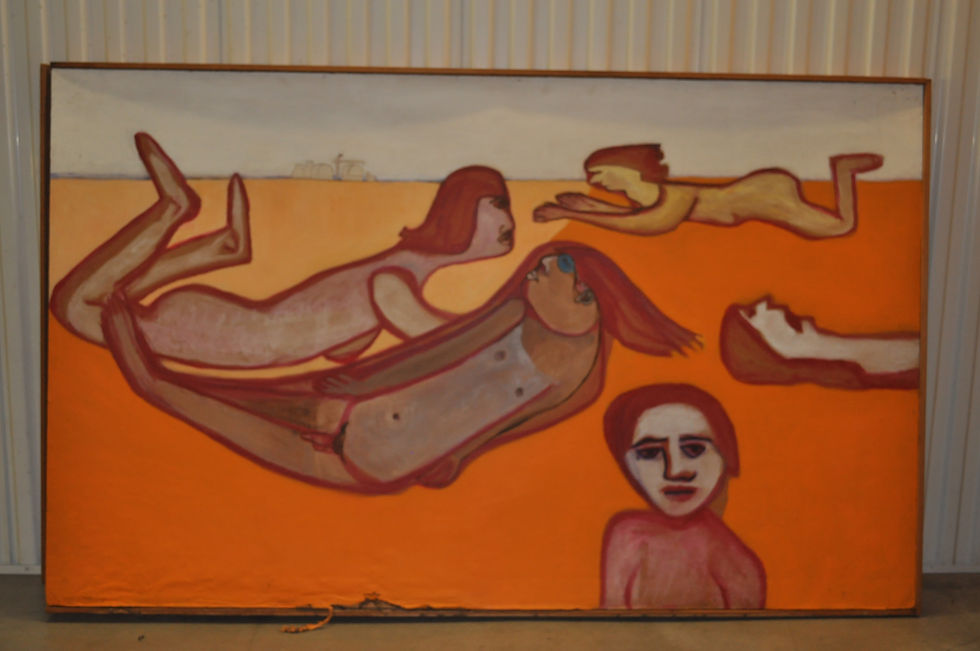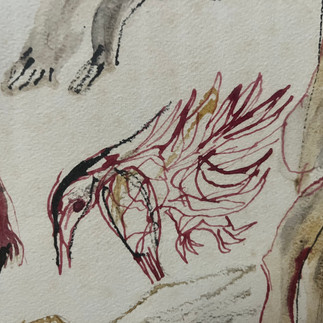Art
“Peter Carr: Artist for Survival”: A Sneak Preview
by Andrew Tonkovich

Thanks to James MacDevitt, Director of the Cerritos College Art Gallery, for choosing the exactly right and true title for the show we are co-curating at his terrific space, opening Monday, October 28. I had suggested some riff on Peter Carr’s “discovery” or rediscovery theme (per his Whitmanic, if also ironically revisionist and yet sincere “The Discovery of California”) but, listening to me talk, fondly and at length (sorry), James heard mention of not only Peter’s involvement with the Southern California and Orange County chapters of the Alliance for Survival but with a group called Artists for Survival. It engaged creative artists of all stripes in the cause of demilitarization, banning nuclear weapons, and shutting down, locally, the San Onofre and Diablo Canyon nuclear power stations.
Peter himself didn’t survive. Complaining about what he thought was an ulcer, he followed his activist-companion Jeanie Bernstein’s advice and went to a doctor, who found nothing predicting the massive heart attack which killed him on February 12, 1981, just a few days after he’d attended a couple of local readings by legendary poet and artist Lawrence Ferlinghetti.
Indeed, the two seem to have corresponded, and become friends. Peter put his drawing, painting, and writing into the service of big causes, whether generally or via specific organizations, or to promote a fellow writer or, frequently, readings by The Laguna Poets. That seems natural for somebody who celebrated activism and artistic engagement, who taught comparative mythology, who challenged and preached and satirized, always embedding overheard dialog or omniscient narrative or jokes or bits of poetry into his work.
Here's the poster he produced toward advertising the second annual Hollywood Bowl concert and rally organized by the Southern California Alliance for Survival, a huge event with impressive speakers and performers.

There’s wit and German Expressionist cartoon in a lot of the work. Think Otto Dix and Kenneth Patchen, with talking people and animals, and Brechtian drollery. I love this tiny drawing, which you might apprehend, correctly, as both a gentle send-up of alienated tourist culture and a sincere invitation to indeed appreciate the natural world. “Look honey, nature.”

As Citric Acid readers will know, I’ve held on to these and, no kidding, thousands (!) of his paintings, drawings, illustrations, notebooks, published books and unpublished manuscripts, believing --- correctly, it now seems --- that his capture of life in Southern California for at least two decades deserves attention and might please others as much as it does me.
He wrote about and painted Aliso Creek, Laguna Beach, Main Beach, downtown Long Beach, the Santa Ana Mountains, the High Sierra, the desert (Anza Borrego), underwater Pacific Ocean landscapes, underground and all-encompassing people-meet-creatures nature scenes and frightening cityscapes where it’s hard to distinguish the carceral or police state from Corporate America. He portrayed a lot of assemblies of people, in celebration or in protest or in otherwise collaborative and communal associations. He painted love and estrangement and resistance and joy. He vigorously if sometimes hilariously hated corporations, the military, advertising, golf, the coercion of fake patriotism, pollution, Nixon, racism, Reagan, war --- perhaps all the evils which you’d catalog under the Subject heading: USA, political and social movements, 1960-1981. Here’s his homage to James Ensor’s “Entry of Christ into Brussels” by way of Long Beach, CA.

Peter was also an eco-artist. This painting features a defining credo, artist’s statement, and another possible title or subtitle for a gallery show. It’s got the arterially composed, almost topographic inter-connected lines, drawn in ink. The images depend on each other, and he fills the scene in with color. Microcosmic, sustainable, a nod to Indigenous wisdom, there’s the assumption of need and mutual aid and oneness. And Whitman and Blake. "I fancied there were other creatures there besides me." He loved ravens, fish, kelp, trees, grasses, insects. He wanted to be one or, more to the obvious point, insisted that we were all creatures, together. Is that a whale in the center?
Here's the McGovern campaign poster he seems to have printed up himself and then given away, or perhaps wheat pasted on walls. The hyperbole, poetic overreach or individualization of a defining historical phenomenon might be forgiven considering the everyday mass murder committed by the US in Southeast Asia just then and for the previous decade. Maybe Peter is attempting here to warn about, re-quantify or reestablish some base level for humanity by way of burning, people, and Holocaust. He served in the Navy in WW II. Like so many, he lived through the actual Holocaust and the miserable conflagration. Insert here your own alternative reality speculation about what our benighted nation might have been had George McGovern won. Almost impossible to imagine, of course, as we witness the assault on voting rights, on our government institutions, reactionary revisionist anti-history, the rise of real fascism, and the ongoing bipartisan US mass murder of Palestinians.

I call this one “Orange Sun,” in part because of its strategic, gorgeous, and spare use of color but also because the work is not signed or dated. Somebody has to call it something. There’s San Onofre on one side, of course, a malign and infinitely poisonous radioactive orange half-life machine on one side, and the beautiful Sun on the other. The painting seems composed as a dialectic, a choice, an opportunity, with the vulnerable or empowered naked dream-people seeming to decide on their direction, on our own direction and fate, in some kind of ancient or modern ritual or spiritual procession.

Here’s another anti-nuke, eco-aware painting, a big one, and a detail from it. This is another favorite. More orange, and lots of it. Maybe it should be titled “Orange Sea.” (Mark Chamberlain, of Laguna’s legendary BC Space, loved this one. He took the photo.)

More naked people, either getting used to the poison from San Onofre or somehow celebrating their doom in a reflexive or natural performance of resistance and, yes, survival. Or maybe sun and water and life have prevailed exactly because of the nude swim-activism of the human family? Or maybe they are now mutant fish-people? Maybe we will be transformed, and all of us survive the meltdown? Maybe the orange of the big planet will have sustained us? I truly love the guy with the blue swimming goggles. Peter? Oh, and yes, San Onofre was finally shut down.
Dr. Peter Carr, a professor and popular teacher in his day job, seems to have over thirty or more years also both continually drawn, painted, illustrated, and written. He sculpted and created jewelry. I find it incomprehensible because I am such a fan, but he was reportedly insecure about his talent while also sharing it just everywhere. Here’s a version of the little card he’d put out at readings, gatherings, fundraisers.

And here’s Peter himself. He figures (pun intended) in plenty of the paintings, with a bald guy, a bald man with glasses, or a rendering of a slightly paunchy naked dude and the simple “Peter” written or scrawled somewhere big or small on the canvas or paper. Check out these two competing self-portraits, one as "saint" and one as doubter. And here he is reading another defining self-published book from 1969, this one with the exuberant, hilarious, Beat-poem title, Bumpers Bugs USA Sex Trees Hair Birds Girls Rocks Lizards Breakfast God Motors Fog Fishes War Sand Gray Ocean Granite.
Finally, here’s perhaps for me the most urgently meaningful and motiving piece in the entire collection, and that’s saying something. It’s an ink and crayon landscape/narrative which hangs over my workspace, in my study, below the “Survival Sunday II” poster. Peter is speaking for himself, and to himself, and to us. And, for these many years, to me. It’s poignant and affirming, of course, and assures me that my quietly obsessive commitment to his work is worthwhile. It’s also perhaps encouraging to all of us, in our individual and collective work on behalf of art, community, peace and justice. It’s a little hard to read the parts drawn over, as it happens, in a dark veil. Here’s the entire text, with no further editorializing (for now) from his biggest fan.
“I felt that the world would end soon and my drawings would all be destroyed. So I did this quickly. --- Peter”
Hope you’ll come out for my lecture and tour, and to see more art and writing on display in “Peter Carr: Artist for Survival,” October 26-December 13 at Cerritos College Art Gallery.


Andrew Tonkovich is the founding editor of Citric Acid and longtime editor of the Santa Monica Review. His fiction, essays and reviews have appeared in the Los Angeles Times, Los Angeles Review of Books, Ecotone, ZYZZYVA, Faultline, Juked, and Best American Nonrequired Reading. He wrote for both OC Weekly and the Orange County Register. With Lisa Alvarez, he co-edited the landmark Orange County: A Literary Field Guide, and is the author of two fiction collections, The Dairy of Anne Frank and More Wish Fulfillment in the Noughties and Keeping Tahoe Blue and Other Provocations. His review of A People's Guide to Orange County appeared recently in Alta online. He hosts Bibliocracy Radio, a weekly books show on Pacifica Radio KPFK 90.7 FM in Southern California and lately available as a podcast sponsored by the Community of Writers.










